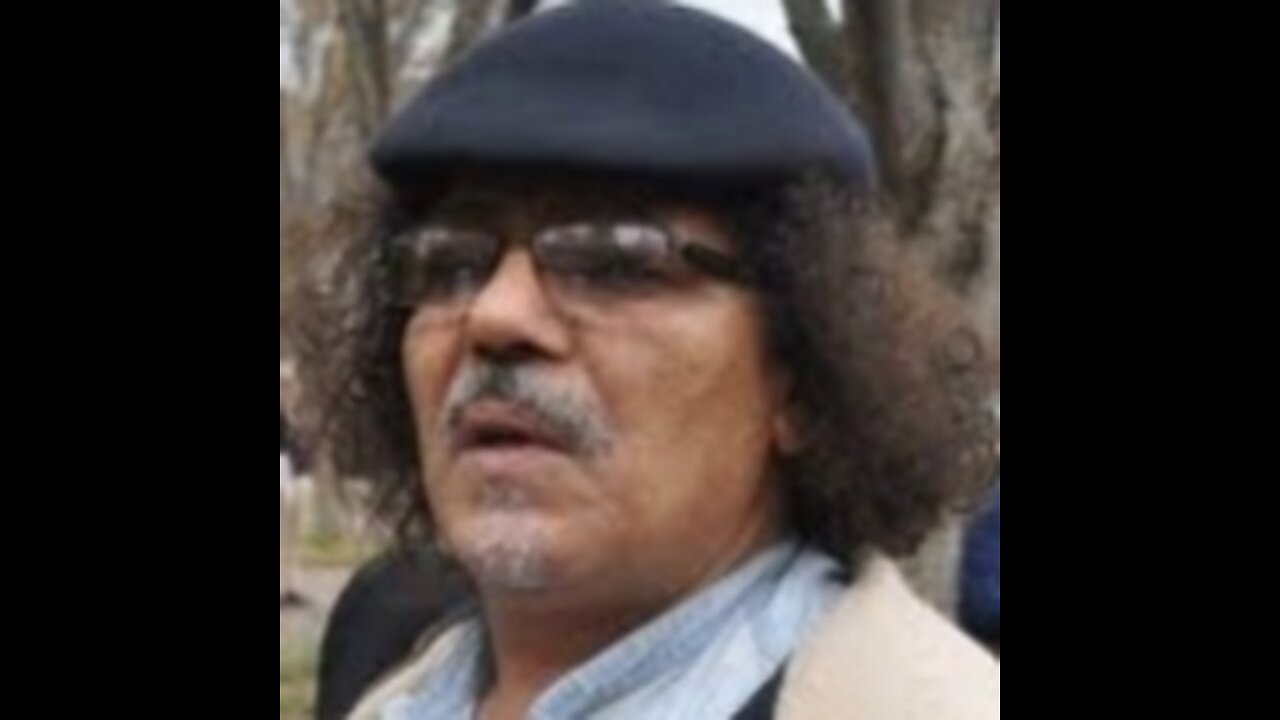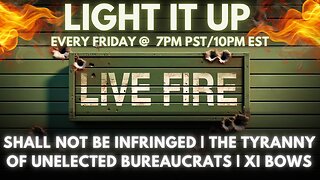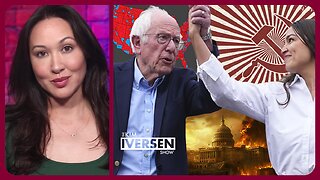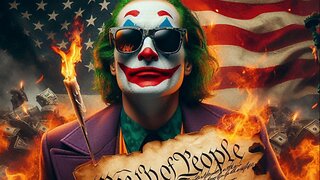Premium Only Content

Morocco the Primitive turbulent Society.
Rif War and Muhammad Ibn 'Abd al-Karim al-Khattabi
Flag of the Rif Republic (1921–1926)
Sultan Yusef's reign, which lasted from 1912 to 1927, was turbulent and marked with frequent uprisings against Spain and France. The most serious of these was a Berber uprising in the Rif Mountains, led by Abd el-Krim, who managed to establish a republic in the Rif. Though this rebellion began in the Spanish-controlled area in the north, it reached the French-controlled area. A coalition of France and Spain finally defeated the rebels in 1925. To ensure their own safety, the French moved the court from Fez to Rabat, which has served as the capital ever since.[42]
Nationalist parties
Amid the backlash against the Berber Decree of 16 May 1930, crowds gathered in protest and a national network was established to resist the legislation. Dr. Susan Gilson Miller cites this as the "seedbed out of which the embryonic nationalist movement emerged."[43] In December 1934, a small group of nationalists, members of the newly formed Moroccan Action Committee (كتلة العمل الوطني, Comité d’Action Marocaine – CAM), proposed a Plan of Reforms (برنامج الإصلاحات المغربية) that called for a return to indirect rule as envisaged by the Treaty of Fes, admission of Moroccans to government positions, and establishment of representative councils. The moderate tactics used by the CAM to obtain consideration of reform included petitions, newspaper editorials, and personal appeals to French.
World War II
Main article: Morocco in World War II
During World War II, the badly divided nationalist movement became more cohesive, and informed Moroccans dared to consider the real possibility of political change in the post-war era. The Moroccan Nationalist Movement (الحركة الوطنية المغربية) was emboldened by overtures made by Franklin D. Roosevelt and the United States during the 1943 Anfa Conference during World War II, expressing support for Moroccan independence after the war. Nationalist political parties based their arguments for Moroccan independence on such World War II declarations as the Atlantic Charter.[44]
However, the nationalists were disappointed in their belief that the Allied victory in Morocco would pave the way for independence. In January 1944, the Istiqlal Party, which subsequently provided most of the leadership for the nationalist movement, released a manifesto demanding full independence, national reunification, and a democratic constitution.[45] Sultan Muhammad V approved the manifesto before its submission to the French resident general Gabriel Puaux, who answered that no basic change in the protectorate status was being considered.[46]
Struggle for independence
The innovative fact about Moroccan nationalists is that they globalized the Moroccan question through transnational activism.[47]: 15 This way they created a vibrant and wide global coalition of supporters who advocated their cause. This way they also managed to make their concerns global ones.[47]: 15 Among their active international supporters was Robert E. Rodes who fought actively in the US Congress for gaining support for the Moroccan cause.[47]: 31–34
In the late 1940s and early 1950s, with political and nonviolent efforts proving futile, the Moroccan struggle for independence became increasingly violent, with massacres, bombings, and riots, particularly in the urban and industrial center, Casablanca.
Tangier Speech and Casablanca Tirailleurs Massacre
Main articles: Tangier Speech and Massacre of April 7, 1947
The Massacre of April 7, 1947 in Casablanca as reported in France-Soir on April 9.[48]
In 1947, Sultan Muhammad V planned to deliver a speech in what was then the Tangier International Zone to appeal for his country's independence from colonialism and for its territorial unity.[49]
In the days leading up to the sultan's speech, French colonial forces in Casablanca, specifically Senegalese Tirailleurs serving the French colonial empire, carried out a massacre of working class Moroccans. The massacre lasted for about 24 hours from 7–8 April 1947, as the tirailleurs fired randomly into residential buildings in working-class neighborhoods, killing 180 Moroccan civilians. The conflict was instigated in an attempt to sabotage the Sultan's journey to Tangier, though after having returned to Casablanca to comfort the families of the victims, the Sultan then proceeded to Tangier to deliver the historic speech, in the garden of the Mendoubia palace, on 9 April.[50][51]
Murder of Farhat Hached
Main article: Casablanca Uprisings of 1952
The assassination of the Tunisian labor unionist Farhat Hached by La Main Rouge—the clandestine militant wing of French intelligence—sparked protests in cities around the world and riots in Casablanca from 7–8 December 1952.[52] Approximately 100 people were killed.[53] In the aftermath of the riots, French authorities arrested Abbas Messaadi, who would eventually escape, found the Moroccan Liberation Army, and join the armed resistance in the Rif.[54]
Revolution of the King and the People
Main article: Revolution of the King and the People
Glaoui's attempted coup
In 1953, Thami El Glaoui attempted to orchestrate a coup against Sultan Muhammad V with the support of the French protectorate.[55] The 1953 Oujda revolt broke out ten days after his "electoral" campaign passed through the city.[56]
Exile of Sultan Muhammad
The general sympathy of the sultan for the nationalists had become evident by the end of the war, although he still hoped to see complete independence achieved gradually. By contrast, the residency, supported by French economic interests and vigorously backed by most of the colonists, adamantly refused to consider even reforms short of independence. Official intransigence contributed to increased animosity between the nationalists and the colonists and gradually widened the split between the sultan and the resident general.
Muhammad V and his family were transferred to Madagascar in January 1954. His replacement by the unpopular Mohammed Ben Aarafa, whose reign was perceived as illegitimate, sparked active opposition to the French protectorate both from nationalists and those who saw the sultan as a religious leader.[57] By 1955, Ben Aarafa was pressured to abdicate. Consequently, Ben Aarafa fled to Tangier where he formally abdicated.[58]
The French executed 6 Moroccan nationalists in Casablanca on 4 January 1955.[59] The aggressions between the colonists and the nationalists increased from 19 August – 5 November 1955, and approximately 1,000 people died[59]
Facing a united Moroccan demand for the sultan’s return, a rising violence in Morocco, as well as the deteriorating situation in Algeria, Muhammad V returned from exile on 16 November 1955, and declared independence on 18 November 1955. In February 1956 he successfully negotiated with France to enforce the independence of Morocco, and in 1957 took the title of King.[citation needed]
1956 independence
In late 1955, Muhammad V successfully negotiated the gradual restoration of Moroccan independence within a framework of French-Moroccan interdependence. Further negotiations for full independence culminated in the French-Moroccan Agreement signed in Paris on 2 March 1956.[60][61]
However, provisions in the protocole annexe of the March agreement as well the Cooperation Agreement of 28 May 1956, which stipulated among other things that each country should refrain from adopting policies that were incompatible with the interests of the other, constituted an impediment to full independence, [62] as was the right of France to maintain troops in Morocco during a transitional period of unspecified duration. The outspoken support of the Moroccans and Muhammad V for Algerian independence brought about the rapid collapse of these agreements and the worsening of Franco-Moroccan relations, especially after the Meknès riots of 23-28 November 1956 in the course of which several hundred Moroccans and more than 50 Europeans were killed. [63] From a high of 350,000 in 1955, the number of European settlers dropped to 150,549 in 1963, and 25,343 in 1990.[64] French-ownership of agricultural land was gradually eliminated following the nationalization decrees of 1959, 1963 and 1973.[65] Following unrelenting diplomatic pressure by Morocco, the last French troops were finally withdrawn 1 November 1961.[66]
The internationalized city of Tangier was reintegrated with the signing of the Tangier Protocol on 29 October 1956.[67] The abolition of the Spanish protectorate and the recognition of Moroccan independence by Spain were negotiated separately and made final in the Joint Declaration of 7 April 1956.[68] Through these agreements with Spain in 1956 and 1958, Moroccan control over certain Spanish-ruled areas was restored, though attempts to claim other Spanish possessions through military action were less successful.
In the months that followed independence, Muhammad V proceeded to build a modern governmental structure under a constitutional monarchy in which the sultan would exercise an active political role. He acted cautiously, having no intention of permitting more radical elements in the nationalist movement to overthrow the established order. He was also intent on preventing the Istiqlal Party from consolidating its control and establishing a one-party state. In August 1957, Muhammad V assumed the title of king.
Monetary policy
Main article: Moroccan franc
The French minted coinage for use in the Protectorate from 1921 until 1956, which continued to circulate until a new currency was introduced. The French minted coins with denomination of francs, which were divided into 100 centimes. This was replaced in 1960 with the reintroduction of the dirham Morocco's current currency.
The Algeciras Conference gave concessions to the European bankers, ranging from a newly formed State Bank of Morocco, to issuing banknotes backed by gold, with a 40-year term. The new state bank was to act as Morocco's Central Bank, but with a strict cap on the spending of the Sherifian Empire, with administrators appointed by the national banks that guaranteed the loans: the German Empire, United Kingdom, France and Spain.[69]
Repression
Hubert Lyautey established the Native Policy Council (Conseil de politique indigène)[70] which oversaw colonial rule in the protectorate.Under the protectorate, Moroccans were prevented from attending large political gatherings.[71] This was because colonial forces deemed they might "hear things beyond their capacity to understand."[71][72]
French authorities also forbade Arabic-language newspapers from covering politics, which sparked claims of censorship.[71] Under the French protectorate, entire articles were censored from the Istiqlal Party's Arabic Al-Alam newspaper, which was printed with blocks of missing text.[73]
Postal history
-
 LIVE
LIVE
I_Came_With_Fire_Podcast
11 hours agoSHALL NOT BE INFRINGED| THE TYRANNY OF UNELECTED BUREAUCRATS | XI BOWS
245 watching -
 LIVE
LIVE
SynthTrax & DJ Cheezus Livestreams
12 hours agoFriday Night Synthwave 80s 90s Electronica and more DJ MIX Livestream THE GREAT EDO WARS OF 2067 Edition
326 watching -
 LIVE
LIVE
RalliedLIVE
3 hours ago $0.71 earnedWarzone Domination w/ Ral
195 watching -
 1:10:17
1:10:17
Sarah Westall
4 hours agoWorld Leaders Increasingly Display Panic Behavior as Economic Change Accelerates w/ Andy Schectman
34.5K9 -
 59:54
59:54
Motherland Casino
2 hours agoScar x Ayanna
1.13K -
 41:57
41:57
BonginoReport
7 hours agoProtecting Kids From WOKE Ideology in School (Ep. 35) - Nightly Scroll with Hayley Caronia -04/25/25
90.5K26 -
 LIVE
LIVE
SpartakusLIVE
4 hours agoFriday Night HYPE w/ #1 All-American Solo NUKE Hero
123 watching -
 LIVE
LIVE
crystalkittn
1 hour agohappy friday lets get littt✨ !motherland
31 watching -
 1:15:07
1:15:07
Kim Iversen
1 day agoThe Left Is Dead — What And Who Will Rise From the Ashes?
91.1K69 -
 2:06:17
2:06:17
Joker Effect
2 hours agoYOU DON'T UNDERSTAND FREEDOM OF SPEECH IF THIS MAKES YOU MAD!
7.67K